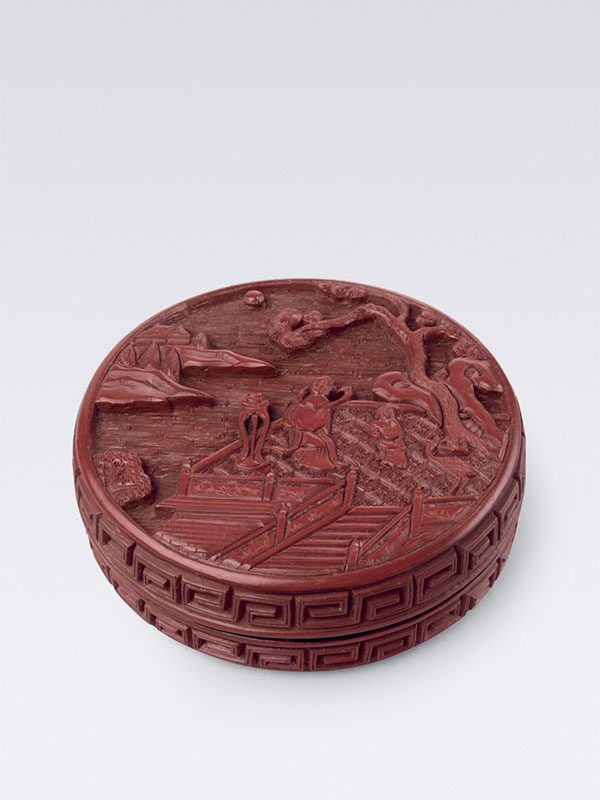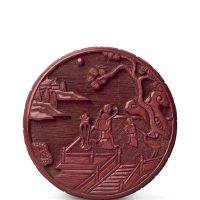Lacquer incense box depicting a scene from Xi Xiang Ji
China, Ming dynasty, 15th century
A lacquer box of circular form with slightly convex sides. The flat top is carved through a thick layer of lacquer and depicts a moonlit landscape with two figures standing on terrace overlooking a lake. A tall lady dressed in voluminous robes with a billowing scarf stands in front of a high-legged table, upon which an incense burner is placed. Behind her stands a servant carrying a parcel, perhaps containing incense, and behind him a crane gazes towards the two figures. The gnarled branches of a pine tree overhang the terrace and almost obscure the full moon. In the distance, a hilly outcrop with a small building and pointed fir trees can be observed. An interlocking key fret pattern denotes the water, whilst starburst diapers indicate the terrace floor. A double continuous key fret band is carved all the way around the sides of both box and cover. The interior and slightly recessed base are plain and lacquered black.
Xi Xiang Ji is a famous Chinese romantic opera depicting the love story between a Mr. Zhang and Ms. Cui Yingying. Depicted on the cover of this beautiful box is a crucial episode of the opera: Cui Yingying Worshipping the Moon. In this episode, Yingying burns incense to worship the moon and to express her love for Mr. Zhang. The quality of the carving and colour of the lacquer of this period are invariably excellent. Carefully carved details such as the billowing robes of the lady, the fine lines incised to denote the bark on the pine tree, and the engraved decoration of bamboo on the panels of the balustrade can be fully appreciated upon closer examination. Comparable lacquer boxes depicting similar landscape settings and with the same key fret design around the sides are in the collection of the Tokugawa Art Museum in Japan.[1] A further closely comparable example was formerly in the collection of Edward Chow is dated by Tregear to the late Ming dynasty.[2]
Provenance:
Ben Janssens Oriental Art, September 2009
Private Collection, UK
1 Karamono: Imported Lacquerwork – Chinese, Korean and Ryukyuan (Okinawa), Selections from The Tokugawa Art Museum Vol. No.2, nos. 102 – 105, pp. 58-59
2 Tregear, M. eds. The Virginia and Edward Chow Foundation & Collections Baur: One Man’s Taste, Geneva, 1988, no. L.13
清/剔红莺莺拜月香盒
《莺莺拜月》为中国著名剧目《西厢记》中重要的一折戏,其描绘了崔莺莺焚香拜月以寄托对张生的相思之情的场景。此盒直壁,子母口。雕刻内容层次丰富,总体分三层:第一层以云纹为地,表达天;第二层深雕刻屋舍、树石以及月亮;第三层雕香案、香炉及人物,包括崔莺莺与侍女。层次鲜明不混乱,景深明显。


